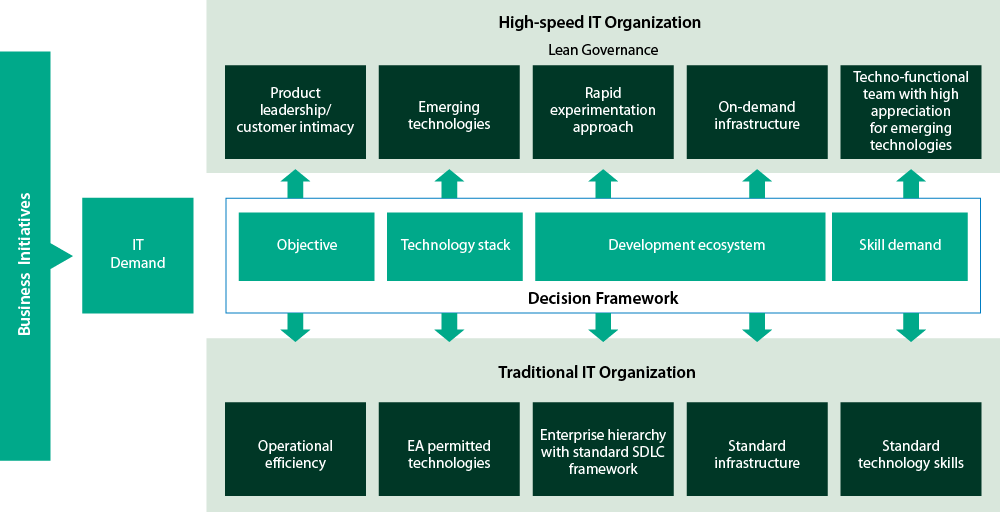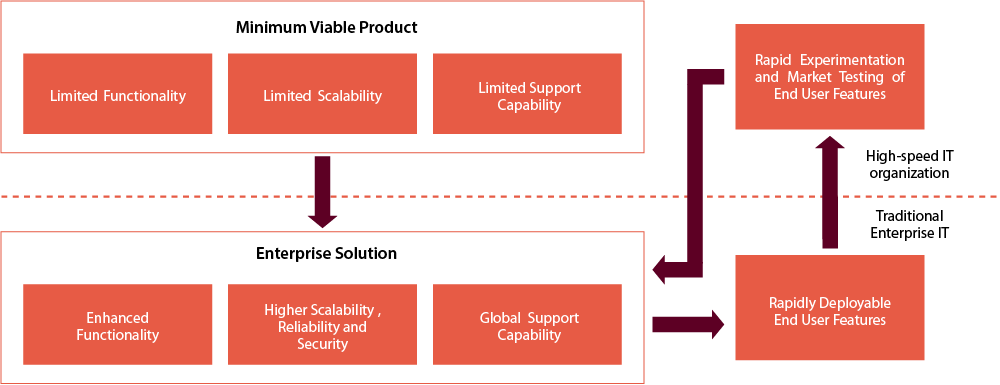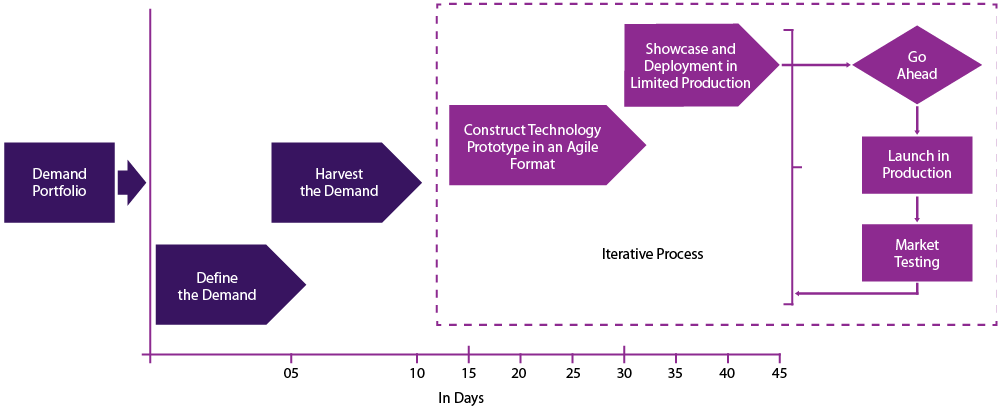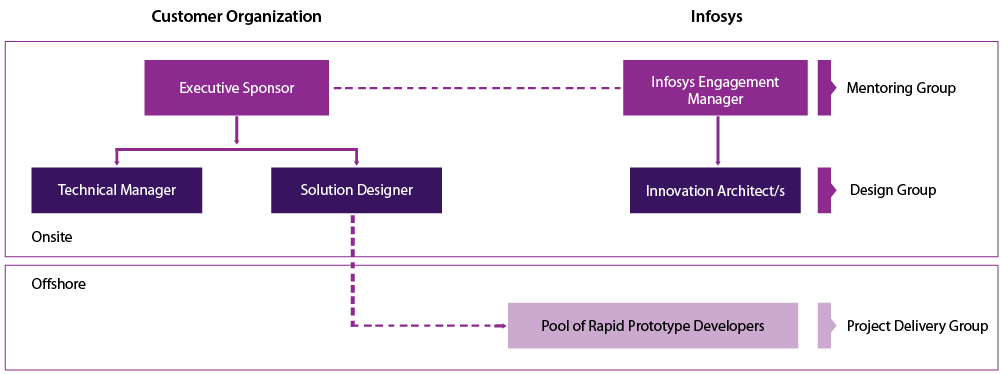-
-
Like what you see?
LetsTalkUrl
Let's Talk
Dhritiman Roy, Mahesh Shripad Athalye, Meenakshi Singh, and Srinivasan Natarajan
Today, organizations across industries are experiencing an unprecedented rate of change driven by technological advances and highly engaged digital consumer. For public sector organizations, the key for differentiation lies not only in meeting the demands successfully, but in meeting the requirements faster with innovative solutions. To strike a balance between speed and stability, public sector organizations need both a traditional enterprise IT function as well as an additional function in the form of a lean IT structure (high-speed IT function). The two-speed model will help public sector organizations in gaining the requisite agility and stability that is needed to be at par with their commercial counterparts and improve mission outcomes.
Today, organizations across industries are experiencing an unprecedented rate of change driven by technological advances and highly engaged digital consumer. To strike a balance between speed and stability, public sector organizations need both a traditional enterprise IT function as well as an additional high-speed IT function. This two-speed (2-speed) model will help public sector organizations in gaining the requisite agility and stability that is needed to be at par with their commercial counterparts and improve mission outcomes. Infosys is partnering with several leading organizations to enable structured innovation leveraging 2-speed IT format.
Example 2: A leading aircraft manufacturer wanted to incubate advanced analytics capabilities for aircraft simulation in a short timeframe. The solution was required for its regional marketing directors and analysts to perform ad-hoc analysis and simulations. The intention was to help their customers (commercial airlines and operators) to make the right strategic decisions by seeing the results of the Example 1: In one of the leading US insurance companies, the CMO wanted to launch a teen driver safety program to engage parents and teenagers in practicing safe driving behavior. The client was looking for innovative solutions leveraging emerging technologies such as telematics and gamified experiences for better customer engagement. The company wanted a rapid market launch of the program to gain competitive edge. To help deliver the program, the client wanted to create a high-speed IT function comprising techno-functional team and lean governance structure that would co-exist with traditional enterprise IT.
The client partnered with Infosys to set up a team outside the traditional IT organization by bringing Cloud infrastructure, emerging technologies based products, lean processes and governance, people, and technology to deliver the innovative program. With this new structure the company was able to launch the platform for a public pilot as a minimum viable product within four months, with subsequent releases in short order. Figure 1 explains life cycle of the Teen Safety program that was delivered through 2-speed IT format.
High Speed IT Set Up
Onboarding of Emerging Technologies
Construction of Minimum Viable Product
Enterprise Solution Construction in Traditional Enterprise IT
Figure 1 Teen Safety program delivered through 2-speed IT format
Example 2: A leading aircraft manufacturer wanted to incubate advanced analytics capabilities for aircraft simulation in a short timeframe. The solution was required for its regional marketing directors and analysts to perform ad-hoc analysis and simulations. The intention was to help their customers (commercial airlines and operators) to make the right strategic decisions by seeing the results of the simulations performed by the analytics applications.
Infosys partnered with the company and helped set up a high speed IT team that could deliver rapid experimentation based on emerging technology concepts which the organization did not have the ability to incubate within the traditional IT organization. The high-speed IT team successfully delivered over 39 projects in 18 months. About 12 proven ideas coming from these high-speed projects were promoted to the traditional IT organization for delivery into production.
These organizations set up a high-speed IT function with a clear focus on delivering projects that require rapid experimentation and market testing.
To help IT leaders to decide on whether a project needs to be executed by high-speed IT or by traditional enterprise IT method, Infosys has created an IT Demand Selection Framework. This framework provides contextual guidelines and helps decision makers to evaluate IT projects based on multi-dimensional evaluation criteria. Figure 2 and Table 1 show the Infosys Demand Selection Framework and its components, respectively.

Figure 2 Infosys Demand Selection Framework
| Table 1 Components of Infosys Demand Selection Framework | ||
|---|---|---|
| Dimensions | High-speed IT | Traditional Enterprise IT |
| Objective of the IT demand | IT demands with an objective of customer intimacy and product leadership that requires continuous market testing for stabilizing ambiguous requirements need to be fulfilled by high-speed IT | IT demand with an objective of operational efficiency or cost reduction with predictable requirements needs to be fulfilled by traditional enterprise IT |
| Technology stack | Open source or any other non-enterprise architecture permitted technology stack | Enterprise architecture defined technology stack |
| Deployment time | 30-45 days avoiding the enterprise change deployment process | 6-12 months |
| Development ecosystem | Partner ecosystem leveraging third party collaboration in an agile format | Enterprise hierarchy using standard SDLC framework |
| Infrastructure demand | On demand | Standard software and hardware infrastructure |
| Developers skillset | Rapid prototype developers with knowledge of multiple technologies and business domain | Specialized technology skills and business analysts for requirement analysis and managementHigh-speed IT |
Integration between the rapid experimentation process and enterprise change deployment process is key for high-speed IT and traditional enterprise IT to coexist. The common guiding principles help in integrating both along with their associated processes (Figure 3).
A minimum viable product developed in a high-speed IT organization has limited functionality, scalability, and support capability. A minimum viable product can be matured into an enterprise application in a traditional enterprise IT function. However, incorporation of new end user features in an enterprise solution may require a higher speed to market and hence could be fulfilled through the high-speed IT. Hence, an intersection of rapid experimentation process with enterprise change deployment process is highly desirable.
To set up a high-speed IT organization, Infosys recommends well-established rapid experimentation process, leveraging best practices from agile, DevOps methodologies, lean governance structure, emerging technology-based solutions, and accelerators and design thinking techniques for creating a precise minimum viable product.

Figure 3 High-speed IT and Traditional Enterprise IT Integration
Infosys follows a 30-40 days rapid experimentation cycle to fulfil IT demands (Figure 4).

Figure 4 Rapid experimentation process in high-speed IT
| Table 2 Rapid Experimentation Phases | |
|---|---|
| Portfolio Phases of Rapid Experimentation Cycle | Key Components |
| Define the Demand |
|
| Harvest the Demand |
|
| Construct Minimum Viable Product |
|
| Review and Showcase Technology Prototype |
|
Following are some of the critical factors for successful execution of rapid experimentation process:
Following are some of the key operational metrics associated with the rapid experimentation process for deploying and testing a minimum viable product (Table 3):
| Table 3 Operational Metrics of Rapid Experimentation Process | |
|---|---|
| KPIs | Measuring Index |
| Deploy velocity | 10x speed of traditional enterprise IT overriding change deployment process |
| Production upgrade lead time | In hours |
| Upgrade failure rate | In percent |
| Mean time to recover | In minutes |
Infosys believes a lean governance structure is required to operate a high-speed IT organization. A lean structure brings the needed agility in operations by building a collaborative culture across the high-speed IT organization. While Table 4 shows lean governance entities in a high-speed IT function, Figure 5 presents an illustrative governance structure in high-speed IT function.
| Table 4 Lean Governance Entities in High-speed IT Function | |
|---|---|
| Governance Entity | Description |
| Mentoring group | Responsible for demand prioritization and fund management |
| Solution design group | Responsible for solution design leveraging design thinking approach |
| Project delivery group | Build, test, and deploy technology prototype |

Figure 5 Illustrative governance structure in high-speed IT function
A scorecard with key performance indicators is a must to measure the success of any high-speed IT function.
| Table 5 Scorecard to Measure Success of High-speed IT Function | |
|---|---|
| Dimension | KPIs |
| Financial |
|
| Customers |
|
| Operational |
|
| Human Capital |
|
Following are some of the policy exceptions that are required to set up a high-speed IT function in an organization:
High-speed IT is not a project or a program level set up, rather it is an enterprise level construct. Combining high-speed IT with traditional IT function, that is, a 2-speed IT format accelerates innovation, improves time to market and changes the mindset of the business to partner with IT. To meet the changing business demands and digital landscape, CIOs today need to evaluate strategy and set up a high-speed IT organization without jeopardizing the traditional IT principles of reliability, security, and governance.
Dhritiman Roy is Management Consultant at Infosys. He has 12 years of experience in IT strategy, transformation and innovation management. He has been instrumental in helping CIOs, enterprise architects with IT management, developing effective IT strategies, improving the performance of the IT function, implementing cost reduction strategies, and defining large transformation programs that have resulted from mergers and acquisitions. His interests include integrating many innovation approaches and techniques together to formulate effective strategies.
Mahesh Shripad Athalye is Senior Manager, Client Services within the Financial Services practice at Infosys. He acts as a trusted advisor to multiple financial clients. He has over 21 years of IT experience in financial services and retail and manufacturing industries. His focus areas include improving client service through innovation-led initiatives, analyzing disruptive technologies and their impact on business value for clients.
Meenakshi Singh is Senior Associate Consultant with Infosys. She has over four years of experience in management consulting. She has led multiple strategic engagements in innovation where she has helped the client in developing effective innovation strategies and in improving the performance of innovation function. Her focus areas include innovation management, technology transformation, and process design and improvement.
Srinivasan Natarajan is Principal Architect at Infosys. He has over 17 years of experience spanning technology consulting, architecture, product development and innovation. He advises clients on accelerating innovation and helps set up joint innovation co-creation centers with Infosys clients. He has been responsible for commercializing Infosys research and IP assets to clients in North America. He is also an innovation practitioner and has facilitated many ideation sessions with leading clients.